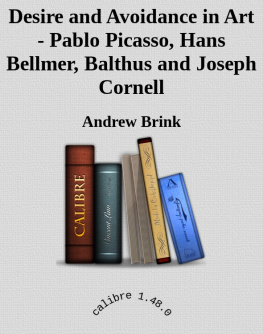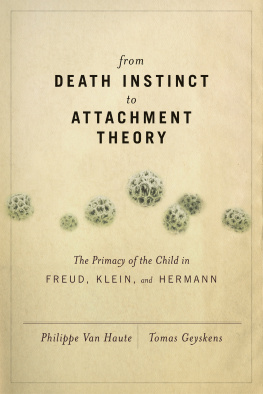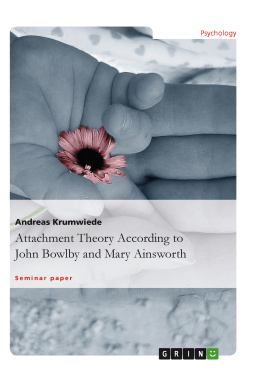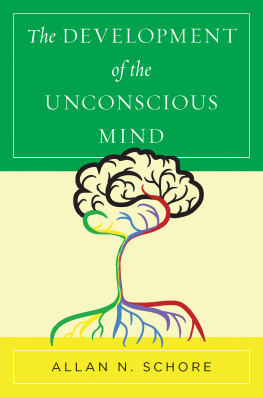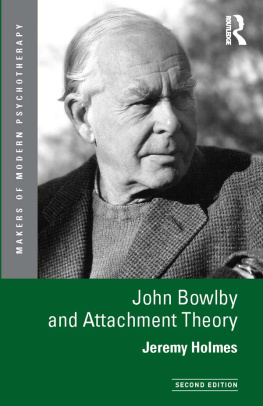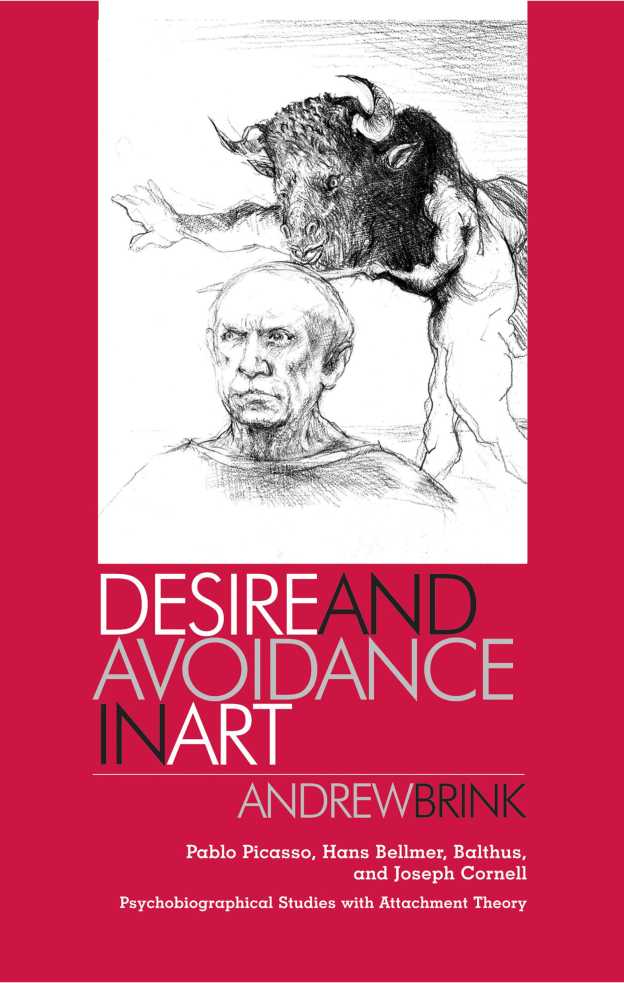DESIRE AND AVOIDANCE IN ART
Contents
Illustrations
Acknowledgments
Introducing Attachment Theory
Too Close: Picassos Adoring and Damaging Portraits of Women
Olga and others
Retrospect: Marina and Olivier
Hans Bellmers Sacrificial Dolls
Misdirection of Play
Desire and Avoidance in the Paintings of
Sacred Profanity
Joseph Cornell: Avoidance and Enchantment
Christian Science
Overcoming Distress
An Impossible Quest: Male Artists Avoiding
Selected Bibliography
Index
DESIRE AND AVOIDANCE IN ART
PETER LANG
New York Washington, D.C./Baltimore Bern Frankfurt am Main Berlin Brussels Vienna Oxford
Andrew Brink
DESIRE AND AVOIDANCE IN ART
Pablo Picasso, Hans Bellmer, Balthus, and Joseph Cornell
Psychobiographical Studies with Attachment Theory
PETER LANG
New York Washington, D.C./Baltimore Bern Frankfurt am Main Berlin Brussels Vienna Oxford
Library of Congress Cataloging-in-Publication Data
Brink, Andrew.
Desire and avoidance in art: Pablo Picasso, Hans Bellmer, Balthus, and Joseph Cornell. Psychobiographical studies with attachment theory / Andrew Brink.
p. cm.
Includes bibliographical references and index.
1. Male artistsBiographyHistory and criticism. 2. Male artistsPsychology.
3. Women in art. 4. Man-woman relationships. 5. Attachment behavior. I. Title. N71.B54 704'.041dc22 2006101662 ISBN 978-0-8204-9721-1
Bibliographic information published by Die Deutsche Bibliothek. Die Deutsche Bibliothek lists this publication in the "Deutsche Nationalbibliografie"; detailed bibliographic data is available on the Internet at http://dnb.ddb.de/.
Cover design by Joni Holst Cover art by John Miecznikowski
The paper in this book meets the guidelines for permanence and durability of the Committee on Production Guidelines for Book Longevity of the Council of Library Resources.
2007 Peter Lang Publishing, Inc., New York 29 Broadway, 18th floor, New York, NY 10006 www.peterlang.com
All rights reserved.
Reprint or reproduction, even partially, in all forms such as microfilm, xerography, microfiche, microcard, and offset strictly prohibited.
Printed in Germany
Contents
Illustrations
Acknowledgments
Introducing Attachment Theory
Too Close: Picassos Adoring and Damaging Portraits of Women
Olga and others
Retrospect: Marina and Olivier
Hans Bellmers Sacrificial Dolls
Misdirection of Play
Desire and Avoidance in the Paintings of
Sacred Profanity
Joseph Cornell: Avoidance and Enchantment
Christian Science
Overcoming Distress
An Impossible Quest: Male Artists Avoiding
Selected Bibliography
Index
Contents
Index
Illustrations
Acknowledgments
My deepest thanks to Helen Brink for the critical reading of successive drafts of this book. Darlene James helpfully read an early version of the Picasso chapter, and Kris Wilson-Yangs comments have improved clarity throughout. Patricia Crittenden generously gave permission to use her Adult Patterns of Attachment chart. John Miecznikowski provided insightful illustrations, and I gratefully acknowledge Kris Wilson-Yangs preparation of the text and index. My thanks to Joshua Kendall for his advice and support.AB
Introducing Attachment Theory
Artists and Psychobiography
Artists who challenge us with extreme statements about how to view women should be asked for reasons why. When the female is distorted in art, entangled and compromised, as well as erotically idealized, the paradox should be explained. Whereas art has long idealized female beauty, certain twentieth century artists rejected traditional canons of taste, replacing them with expressive distortions. Historical and cultural explanations may be given as to why art can never return to the chaste medieval Madonna or the classical purity of an Ingres nude. There are many staging grounds in art history for the eventual distortions of female beauty seen so dramatically in the work of Pablo Picasso, Hans Bellmer, and Balthus. It is not my purpose to trace the historical course to their innovations. My purpose is to offer psychobiographical explanations for the necessity of expressive distortions of women in their art. These distortions are not only of personal origin but also reflect the changed spirit of the age and hence changed receptivity in the artists public. Historical and social questions hover in the background, but my problem is to show believable causes for these particular artists life-long pursuit of the obsessive themes that so compromise their images of women. The quest is to find convincing developmental origins of their love-hate of women, as reflected in their art.
Psychobiography is risky business. The most celebrated psychobiography of an artist, Freuds study of Leonardo, has been severely criticized if not discredited.1 The most poignant risk factor is the writers own uncorrected wish to see what he wants to see in his chosen subject. He may write to justify, or to dispel, his own fears without recognizing what he is doing. Psychobiographers pick not only puzzling and challenging subjects, but those speaking to their own conflicts. Provided there are safeguards, this is as it should be. Awareness must be maintained that the psychobiographers bias and unconscious need can easily skew the exercise. It is hoped that others will feel as I do, that the images of women found in works by Picasso, Bellmer, and
Balthus are, in varying degrees, abusive and need explaining. Exactly how abusiveness touches me may not be quite so important as working by a good psychological theory encompassing writer and subject. Well-applied theory helps to control the powerful feelings generated by working with the provocative material in this study.
That theory is attachment theory, a radical revision of the Freudian psychoanalysis that has so long held sway in explaining art and artists. While i have no wish to jettison many important insights of psychoanalysis, nor the published work to which they have led, i do think that the promise of attachment theory is so great that some trial exercises are justified. An earlier attempt to apply attachment theory to products of creativity was made in my Obsession and Culture: A Study of Sexual Obsession in Modern Fiction (1996), but I believe that both theory and examples can be improved. The main requirement of good psychobiography is a sound theory applied to a rich array of data from the life, especially during the critical phases of parenting in infancy and childhood. As William Todd Schultz points out, the psychobiographers task is not to diagnose his subject, risking the reductionism of mere pathography, but to understand his motivation as fully as possible from studying a full array of biographical facts. In good psychobiography cogent interpretations
Next page
